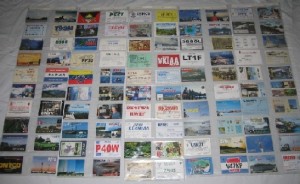 I’ve been working intensely since upgrading to knock out my first 100 countries on the
I’ve been working intensely since upgrading to knock out my first 100 countries on the
amateur bands. Taking care of it in less than 6 months with the present solar conditions
shows that there still is plenty of DX on the air, if you have the time to hunt them down.
Here are a couple of other thoughts about the present state of the DX world.
I think it is important to note that all of this work was done with wire antennas. I had
three different antennas up at the house during this time period, and then of course there
are two more out at WA4FC. I also think I should mention the importance of
RESOSANT antennas. I had a 20m dipole that I did most of the 20m work with, and a
40m end fed dipole that absolutely knocked peoples socks off on that band. I just sloped
it to the corner of the yard. And then, the G5RV (resonant on 80) helped bring my score
up on 80m very easily. Every QSO was made with no more than 100 watts, a fitting
power level for the first 100 countries. A modest station is all that’s required to make
something like this happen. I wasn’t seeking pain to actually try and do it totally QRP,
but there are folks like that. I
I would certainly suggest that if you are going to go after any awards that you find
yourself an automated logging program that suits you and can help organize your results.
It was nice to just bring up the analysis function in Ham Radio Deluxe Logbook software
and see what I had worked, and run a quick report to see what was confirmed. It also
automatically imported data from QRZ.com.
One easy way to bring up your score is to enter in a couple of the larger contests. I did
CQWW a weekend or two after I upgraded, and knocked out 30-40 countries right there.
I just went at it fairly casually (12-16 hours or so spread out over the weekend) and it
turned out well.
The DX cluster brings lots of interesting comments from folks. I will just mention that it
can help you know when the band is open in certain directions, and help chase down
certain things. But get out there and find some on your own too.
DX Nets also tend to bring controversy into conversation, but if you treat things right and
actually make unassisted 2 way QSOs, you can rest that you knocked out a few good
ones that way as well. Check out 14.247 mhz at 3pm eastern every day except Sunday.
You’ll need to learn the ropes of QSLing, including how to get some back direct if you
want to make this happen in any decent amount of time. I recommend QSLing direct
obviously if they prefer or note in their QRZ bio they don’t participate in the buro or their
country doesn’t have one. QSOs with the same op on multiple bands are also good ones
to send direct, you get more bang for your buck. Speaking of buck, most folks now
want $2 for direct, or one NEW IRC (see my article a month or so ago). Some managers
will let you combine as well; check their bio for details. SASEs are a must.
Finally, I want to mention the propagation conditions. Study them, and learn what the A
and K index do to your daily operating. There is more to the conditions that just the solar
flux. So what is next, you ask? I’m going to do it all over again on each band, and each
mode, etc just for fun.
